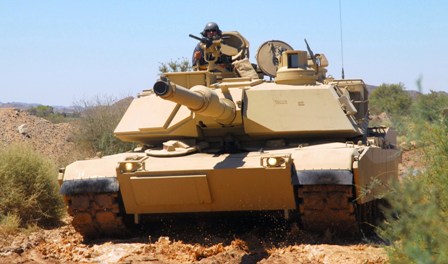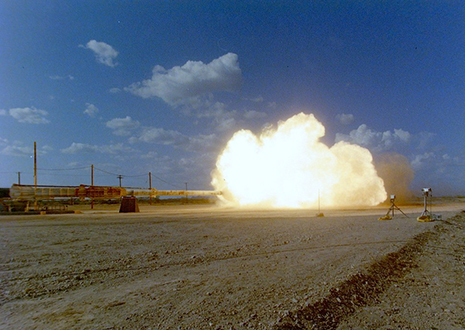- Homepage >
- History
Yuma Proving Ground Continues Area's Army History
The presence of the U.S. Army in Yuma goes back to 1850, when Fort Yuma was constructed on a hill overlooking the important Yuma crossing of the Colorado River. Soldiers at Fort Yuma maintained peace with the local Indians and protected the important crossing, which was used by thousands of travelers each year. The fort operated until 1883.

A second facility, the Yuma Quartermaster Depot, was constructed in Yuma next to the Colorado River in 1865 to act as a supply base for Army posts throughout Arizona and part of New Mexico. Supplies were delivered to the depot by riverboats and transported from there to various military outposts by wagon. The depot operated for 18 years. After it closed, Army personnel were not to return to Yuma on a permanent basis until World War II.
The U.S. Army Corps of Engineers opened the Yuma Test Branch near the present site of the proving ground below Laguna Dam on the Colorado River in 1943. This location was considered the most desirable spot in the country for the testing of portable combat bridges because of the abundance of swift flowing water that engineers could control as they wished. In late 1944, rice and hemp plants were grown next to the Colorado River to establish realistic conditions for testing troop and vehicle movements in preparation for the expected invasion of Japan.
At the same time the test branch began operating, the Army established Camp Laguna a few miles to the west to train troops in mechanized warfare. Camp Laguna was one of 12 major U.S. Army desert training camps in the California-Arizona Maneuver Area (CAMA). An 18,000 square mile area chosen by General George S. Patton, this became the training ground for over one million soldiers.

Upward of 15,000 troops were stationed at Camp Laguna at any one time for periods generally lasting six months. The purpose of the challenging training was to prepare soldiers for a severe life of combat in the deserts of North Africa or one of World War IIís other combat fronts. Camp Laguna and the other CAMA installations were crucial in preparing Army personnel for combat. Camp Laguna was deactivated and demolished in 1944. Other nearby CAMA facilities were Camps Pilot Knob, Hyder and Horn.
After the war, the Yuma Test Branch remained in operation, but testing activities were turned toward the effect of the desert environment on engineering equipment, such as high-speed tractors, semi-trailers and revolving cranes. In 1950, the test branch closed, only to reopen one year later with a new name, Yuma Test Station, and a greatly expanded mission.

This new mission saw the testing workload greatly expand beyond its river and desert environmental roots. It became a multi-purpose test center that took on the lionís share of the nationís artillery testing workload, with the longest overland artillery range in the country. In addition, many types of armored vehicles, armored systems, and air delivery systems began to be tested.
With the reorganization of the Army, the installation was renamed Yuma Proving Ground in 1963. In 1971, the aircraft armament testing mission was permanently relocated from Aberdeen Proving Ground, Md., to Yuma Proving Ground. Three years later, the proving ground was designated as a Major Range and Test Facility Base.
Numerous notable tests occurred over the years. As the Armyís premier long-range artillery tester, extensive tests took place on systems for all the U.S. services and for the nationís NATO allies. Expansive testing ranges easily accommodated large explosive tests. Unlimited airspace, exceptionally long ranges and the availability of full system weapon maintenance combined to make ideal artillery testing conditions.
In the mid-1960ís, the 119-foot, 240 ton High Altitude Research Project (HARP) gun was constructed from two Navy 16-inch gun tubes to fire projectiles into the lower reaches of space. An experimental projectile was fired late in that decade to an altitude of 111 miles and landed on the proving ground about 30 miles from where it was fired. The gun still sits at the proving ground today.
In 1971, the most highly instrumented helicopter armament test range in the United States was constructed at the proving ground and has continuously been upgraded over the years. Known as the Cibola Range, it is uniquely suited to support testing of aviation systems and munitions, armed helicopters, air delivery systems, unmanned aircraft, and precision navigation systems. The range measures 18 miles wide and 40 miles long. The AH-64 Apache helicopter underwent all developmental testing in Yuma, and continues to be a frequent visitor today.
Yuma Proving Groundís testing of unmanned aerial systems dates back to the late 1950ís, when the first hangar at Castle Dome Heliport, one of the proving groundís multiple airfields, was constructed to support a drone competition. With eight launching sites and nearly 2,000 miles of restricted airspace, the proving ground is as close to an ideal venue for unmanned aircraft testing as can possibly exist. The clear, stable air and extremely dry climate, where inclement weather is a rarity, makes it highly coveted by both military and commercial customers. YPG has conducted extensive testing and weaponization on such diverse platforms as the Predator and the Fire Scout.
Beginning in the mid 1970ís, all developmental work on the global positioning system (GPS), which has both military and civilian applications, took place at Yuma Proving Ground. The testing came to YPG after the proving ground demonstrated it could conduct development at a lower cost and provide test data in a way no other test facility could at that time. The Precision Aerial Tracking System developed by Yuma engineers made this possible, as did specialized computer software designed at the proving ground. The GPS testing involved three flights a day for over ten years following the completion of significant upgrades to range instrumentation. GPS testing was a major component of the proving groundís workload during this era.
Over 240 miles of automotive test courses and other test facilities capable of handling nearly all types of field performance and controlled engineering tests have been established at the proving ground. These include paved inclines, side slopes, obstacles, calibrated ride and handling courses, a skid pad for dry and wet pavement handling, various material mud courses with adjustable moisture content, a Middle East cross country course, and others. These courses furnish variations in road, terrain and soil conditions, offering test engineers the ability to select any degree of severity desired for endurance and reliability or desert environmental testing. Hundreds of thousands of testing miles have been put on significant military systems like the M-1 Abrams tank, the M3 Bradley Fighting Vehicle, Stryker Armored Vehicle, and many others. Testing at YPG was instrumental in the dramatic extension of the usable lifespan of vehicle tracks used on platforms like the M-1 and Bradley, from hundreds of miles in the early 1990ís to thousands of miles today.
Many foreign governments took notice of the proving groundís unique capabilities and arranged with the United States government to bring some of their equipment to Yuma for testing. Japanese troops, for example, visited the proving ground for long periods over several consecutive summers to conduct testing on a Mitsubishi-designed self-propelled howitzer. Germany visited to test a howitzer system designed in the country for use in a desert environment. Jordan examined a border surveillance system, Canada and the Saudi Arabian National Guard tested armored vehicles, and numerous other nations such as Britain, France and Singapore conducted a wide variety of tests.
As a result of the 1988 round of the Base Realignment and Closure (BRAC) process, production acceptance testing of 105mm and 120mm rounds at Jefferson Proving Ground, Ind., was consolidated at Yuma Proving Ground on the Kofa Firing Range.
Before and during the Persian Gulf War of the early 1990ís, all the primary ground weapon systems deployed to Saudi Arabia underwent exhaustive tests at the proving ground. The campaignís lightning victory was partly due to the extensive testing that took place at the proving ground. In the years leading up to the war, nearly every item in the Armyís ground combat arsenal went through testing at the proving ground.
Yuma Proving Ground has played a decisive role in supporting Soldiers deployed to Southwest Asia after the 9-1-1 tragedy. When mortar attacks constituted the deadliest threat to American forces in the early days of operations in Iraq, the proving groundís rapid testing of Counter Rocket and Mortar technology neutralized the danger. When insurgents shifted to the use of deadly roadside bombs and other improvised explosive devices, YPG constructed highly instrumented mock villages that simulated not only the physical characteristics of Southwest Asian urban areas, but the electromagnetic environment that affects electronic equipment. Technologies that minimize the threat of improvised explosives continue to evolve and continue to be tested.
Needing an upgraded track to test combat vehicles, YPG partnered with the automaker General Motors (GM) in 2007. The deal resulted in the construction of paved and unpaved courses used by GM for hot weather testing of commercial vehicles, and the Army for military vehicles. GMís Desert Proving Ground opened at the proving ground in 2009 and today tests virtually all vehicles manufactured by the firm.
Today, the proving ground continues its busy work schedule. Major initiatives are being carried out to test the Armyís newly developed extended range cannons that can accurately fire twice the distance of current artillery, and counter-unmanned aircraft technologies. The proving ground actively supports six of the Army Futures Command's Cross Functional Teams (CFTs) building the Army's future force, which seeks to retain overmatch with near-peer adversaries in a high intensity conflict while maintaining the competency in waging irregular warfare that has been achieved since the 9/11 attacks.
For the past ten years in a row, more direct labor hours are devoted by proving ground personnel to testing activities than any other test organization in the Army. The areas of cargo and personnel parachute technologies and the testing of unmanned aircraft, in particular, continue to grow each year.
There are four extreme natural environments recognized by testers as critical in the testing of military equipment. Of the four, three fall under the management authority of Yuma Proving Ground.
Desert natural environment testing takes place at Yuma Proving Groundís Yuma Test Center, with cold weather testing taking place at the Arctic Regions Test Center, Alaska, and tropic testing at the Tropic Regions Test Center, which operates in Hawaii, Panama, Suriname, and other tropic areas. Realistic natural environment testing ensures that American military equipment performs as advertised, wherever deployed around the world.
As one of the geographically largest military installations in the western world, Yuma Proving Groundís over-75-year history has witnessed a huge and varied workload. Todayís mission, as throughout its history, is to ensure that weapon systems and equipment issued to American Soldiers function safely and as intended -- all the time, without fail. This workload directly contributes to Americaís national defense, a source of intense pride for each of the over 2300 Yuma County residents who work at the proving ground.
